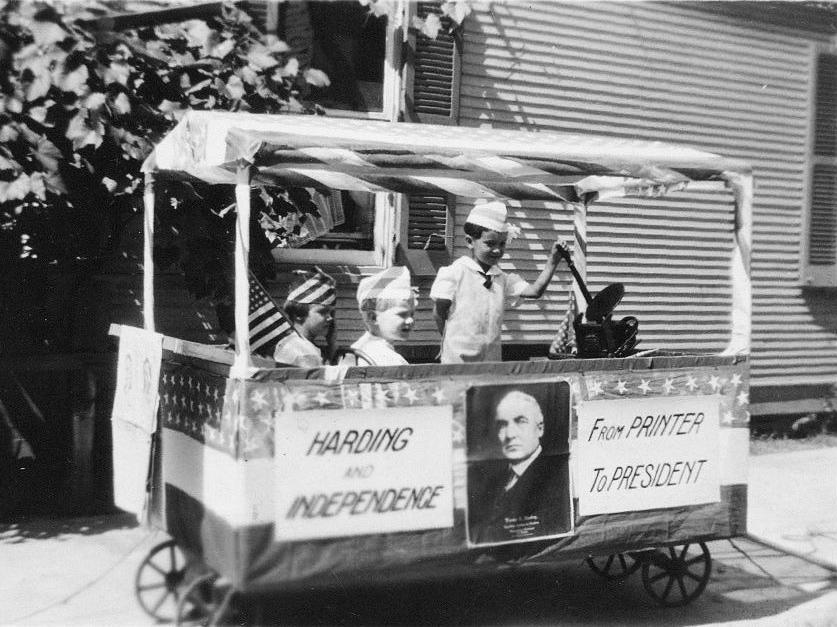
United States 1920 Presidential Election: Campaign

Figure 1.-- Here we see kids getting involved for what seems like a Republican campaign parade during summer 1920. It appears to be a view of what seems to be a children's parade float mounted on wheels to be towed. Three children are inside the patriotically decorated display. The float is promoring theelection of Dentor Warren G Harding, "From Printer To President", and a small hand-operated metal letterpress can be seen and a photo of Harding. "Harding and Independence" probably refers to the defeat of President Wilson's plan of joining the new League of Nations which was seen as infringing on American independence. The children were probably from the St. Louis area.
|
|
Harding virtually ignored Cox, the Democratic nominee, and ran against President Wilson. Although it had taken 44 ballots to win the nomination, Govenor Cox was a very capable individual who unlike Harding had the intelectual and administrative skills to be president. [Stone] Cox was a reformed-minded govenor who strongly supported the Wilson Administration and its reform agenda. America in 1920, however, was not looking for a reformer. Cox backed the internationalist policies of Woodrow Wilson and favored U.S. entry into the League of Nations. This also did not help him in the general elction as many Americans had alreay begun to question American participation in the War ad departure from traditional isolationism.
Americans had just experienced 4 tumultous years, including war with substantial casualties, an economic boom and subsequent slump, strikes, and other disorders. They were especiallydisenchanted with the War and American involvement in Europe. The Harding campaign was managed by Republican National Chairman William Harrison Hayes. Harding called for a return to "normalcy". While not an actual word, it proved to be a successful campaign slogan. Harding also had a huge campaign spending advantage. Harding proved a popular choice for the Republicans in 1920. His affable personality and relatively moderate political positions such as advocating a return to lnormalcyl appealed to the American public. Harding's wife Florence played a major in the campaign which was at the time unusual. She actively cultivated relations with reporters. And as business manager of the Star she knew how to do it. She also coached her husband in such matters as to how to wave to newsreel cameras. The most notable aspect of the 1920 campaign was that it was the first time women were allowed voted for president. And Harding had supported the 19th Amendment. This and Hardings good looks meant that he dominated this new demographic. Harding also received the support of two previously Democratic constituencies--the Germans and Irish. Both had opposed American entry into World War II and felt percecuted by the Wilson Administratiin during the War.
CIH

Navigate the Children in History Websitee:
[Return to the Main U.S. 1920 election page]
[Return to the Main U.S. presidential page]
[Return to the Main U.S. political party page]
[Return to the Main U.S. history page]
[About Us]
[Introduction]
[Biographies]
[Chronology]
[Climatology]
[Clothing]
[Disease and Health]
[Economics]
[Freedom]
[Geography]
[History]
[Human Nature]
[Ideology]
[Law]
[Nationalism]
[Presidents]
[Religion]
[Royalty]
[Science]
[Social Class]
[Bibliographies]
[Contributions]
[FAQs]
[Glossaries]
[Images]
[Links]
[Registration]
[Tools]
[Children in History Home]
Created: 12:47 AM 11/12/2017
Last updated: 12:47 AM 11/12/2017



